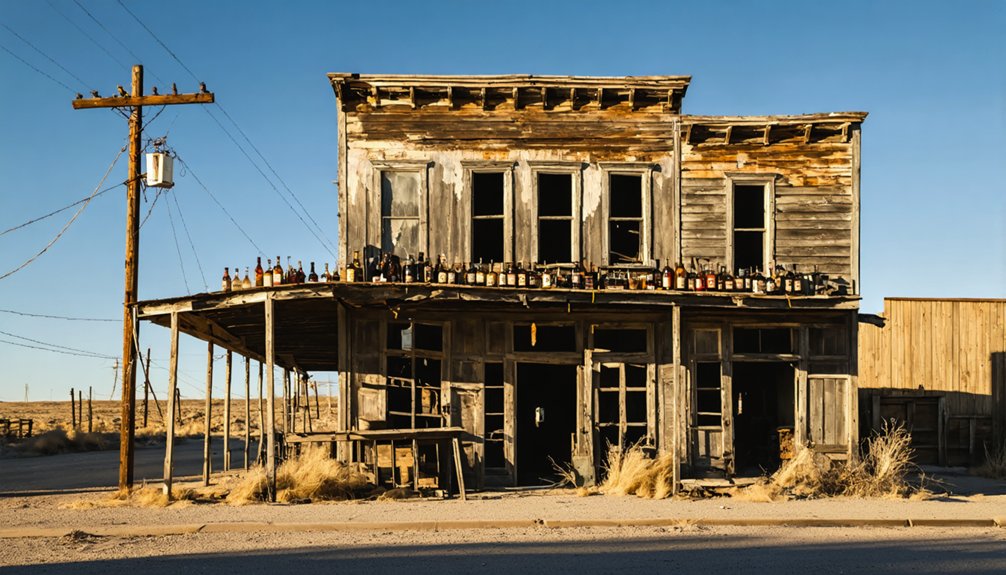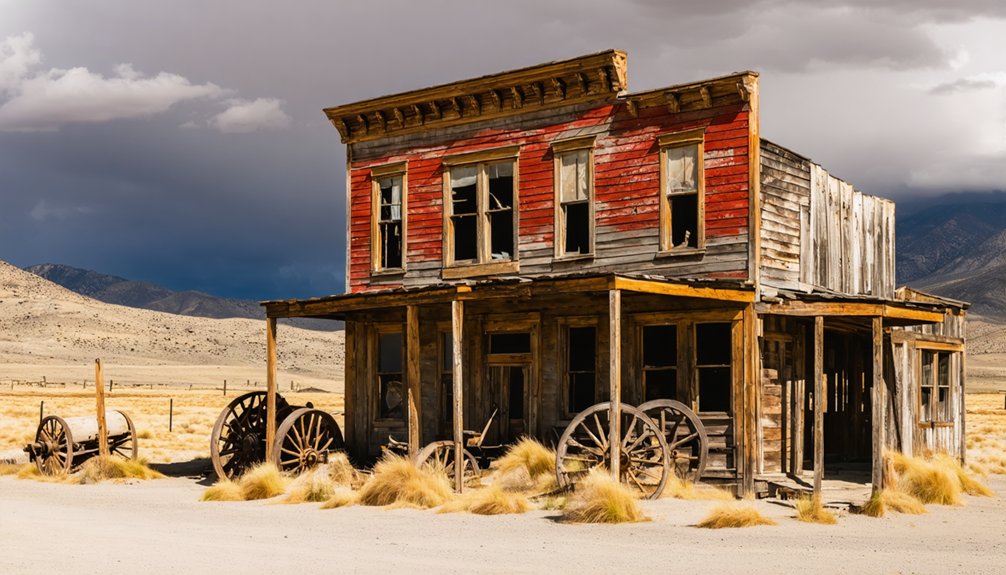You’ll find the term “ghost town” emerged during America’s westward expansion of the 1870s, describing abandoned settlements that dotted the frontier landscape. These places earned their spectral name because they stood like phantom versions of once-thriving communities – structures intact but eerily devoid of human life. When mining operations ceased or economic lifelines disappeared, these towns became silent shells of their former selves, their empty buildings and quiet streets evoking a haunting, ghost-like presence that continues to captivate visitors today.
Key Takeaways
- The term originated during America’s westward expansion (1870-75) to describe abandoned settlements across the frontier.
- Ghost towns earned their name from their phantom-like quality, with empty buildings standing like spirits without human presence.
- The eerie silence and absence of human activity create a haunting atmosphere that inspired the “ghost” metaphor.
- Like ghosts, these towns represent remnants of the past, with empty structures serving as silent witnesses to vanished communities.
- The name reflects how these places appear frozen in time, with abandoned buildings creating an unsettling, spectral quality.
The Origins and Etymology Behind the Name
The term “ghost town” emerged during America’s westward expansion between 1870-75, capturing the haunting essence of abandoned settlements across the frontier.
The etymological roots of this phrase stem directly from the visual impression these deserted places left on observers – empty buildings standing like specters of their former vibrant selves.
While you wouldn’t have heard the term during the actual boom periods of western settlement, its historical significance grew as more mining camps and frontier communities fell into abandonment.
The metaphor perfectly described the phantom-like quality of these places, where intact structures remained but human presence had vanished.
These abandoned settlements, often found in mountainous terrain, became increasingly common as natural resources were depleted in various regions.
As railways shifted, mines depleted, and disasters struck, these towns transformed into silent testimonies of the American West’s boom-and-bust cycle. These abandoned settlements perfectly embodied what historian Lambert Florin called a shadowy semblance of their former selves.
How Empty Buildings Echo the Past
Standing as silent sentinels of history, empty buildings in ghost towns speak volumes about the communities that once thrived within their walls. Through architectural storytelling, you’ll discover rare craftsmanship and materials that modern structures rarely showcase, from ornate woodwork to hand-carved stone details.
These abandoned spaces reveal the cultural preservation of past ways of life through their spatial layouts and decorative elements. The gradual decline of these sites often leads to diminished community character as unique architectural features are lost to time. Demolishing these historic structures permanently erases community identity and severs ties to the past.
You’ll find yourself surrounded by physical evidence of previous generations – their daily routines, social gatherings, and economic activities all captured in weathered facades and empty rooms.
The buildings’ natural degradation creates a haunting atmosphere that connects you directly to bygone eras. As you explore these quiet structures, you’ll experience how they continue to shape local identity and inspire efforts to protect our shared heritage.
When Life Departs but Structures Remain
You’ll find that ghost towns earn their eerie name from the stark contrast between their standing structures and their missing inhabitants.
When you walk through these abandoned places, you’re surrounded by buildings, streets, and infrastructure that remain as silent witnesses to a once-thriving community. Many of these locations became deserted after their natural resources were depleted.
These physical remnants tell stories of sudden departures and gradual exoduses, whether caused by economic collapse, natural disasters, or other forces that drove residents away while leaving their built environment behind. Some of these deserted locations have been transformed into tourist attractions that preserve their unique history.
Abandoned Yet Still Standing
While most inhabited towns bustle with daily life, ghost towns stand as silent monuments to their former liveliness, with 75% or more of their structures remaining empty and unused.
You’ll find remarkable examples of abandoned architecture where time seems frozen – stores still stocked with goods, desks waiting in empty classrooms, and church pews collecting dust.
The structural preservation varies dramatically depending on building materials and climate. Stone foundations often outlast wooden upper structures, while brick buildings show impressive durability against time’s passage.
In places like Bodie, you’ll discover exceptionally well-preserved interiors that tell stories of sudden departure. Archaeological investigations often rely on metal detecting methods to locate and study the most barren ghost town sites.
Even when natural disasters, economic collapse, or conflicts drive residents away, many buildings remain standing as evidence of the communities that once thrived there. In Turkey’s Kayaköy, the population exchange treaty led to entire villages becoming frozen in time as their inhabitants were forced to relocate.
Empty Streets Tell Stories
Empty streets in ghost towns serve as powerful storytellers, revealing layers of history through their abandoned spaces and silent structures. As you walk these deserted paths, you’ll discover silent narratives etched into every weathered building and forgotten storefront.
The absence of bustling life creates an atmosphere of urban solitude, where historic landmarks stand frozen in time. You’ll notice how nature slowly reclaims these spaces, with climbing vines embracing old walls and wildlife making homes in vacant buildings. Like Ware’s quiet town streets, these abandoned pathways create an almost meditative environment for visitors to reflect. In Kangbashi, the bronze horse statues stand as silent sentinels amidst the emptiness.
Public spaces like parks and plazas, though empty, preserve memories of community gatherings. The architectural remains – from bell towers to shopfronts – speak of economic shifts and demographic changes that led to abandonment.
Each empty street becomes a living museum, where structural decay and seasonal changes continue to write new chapters in the town’s ongoing story.
Silent Buildings Bear Witness
Silent buildings stand as haunting monuments in ghost towns, their weathered walls and broken windows telling stories of communities that once thrived.
You’ll find residential homes and churches most commonly abandoned outside urban centers, while old industrial buildings like furnaces and slaughterhouses dot the landscape as silent witnesses to economic decline.
As time passes, nature reclaims these forgotten structures. Boarded-up doors, shattered glass, and overgrown weeds create a stark portrait of urban decay.
These abandoned buildings aren’t just empty shells – they’re physical reminders of departing populations and declining prosperity. Their presence drives down nearby property values and attracts crime, particularly arson.
Each year, thousands of fires break out in these vacant structures, making them not just symbols of the past, but ongoing hazards in the present.
The Eerie Atmosphere of Abandoned Places

When you enter a ghost town, you’ll immediately notice the haunting silence that fills once-bustling streets, broken only by the whisper of wind through decaying buildings and the creak of weathered boards.
The mystery deepens as you observe the abandoned structures with their crumbling walls, broken windows, and personal belongings left behind as if frozen in time.
Nature steadily reclaims these empty spaces, with plants pushing through floorboards and desert sands drifting through doorways, creating an unsettling blend of human absence and wild persistence.
Haunting Silence Fills Streets
Standing in a ghost town feels like stepping into a vacuum of time, where the profound silence hits you with an almost physical force. The whispers echoing through empty streets tell stories of vacant memories, where life once thrived but now stands frozen.
The absence of human activity creates an unsettling quiet that you’ll notice immediately:
- No footsteps clicking against worn pathways
- Wind whistling through abandoned buildings becomes amplified
- Wildlife sounds seem unnaturally loud in the stillness
- Creaking structures and settling foundations break the silence
You’ll find yourself straining to hear traces of the past, but only nature’s sounds remain. The contrast between what once was and what’s now creates a disorienting experience, as if the town itself holds its breath, preserving the last moments before its abandonment.
Decaying Buildings Create Mystery
Beyond the haunting silence, decay etches its presence into every surface of a ghost town’s abandoned structures. You’ll find peeling paint, broken windows, and collapsed roofs telling decay narratives of long-term neglect.
Weather, plants, and animals actively reclaim these spaces, creating an atmosphere of haunting visual intrigue. As you explore these deteriorating buildings, you’ll notice how nature accelerates their transformation.
Rain seeps through crumbling masonry, while vines crack foundations and rust corrodes metal fixtures. Empty doorframes and sagging floors reveal glimpses of past lives, while abandoned personal items create mysterious storylines of sudden departure.
The interplay of light and shadows on weathered walls heightens the eerie ambiance, making every crumbling structure a reflection of time’s relentless march and humanity’s fleeting presence.
Nature Reclaims Empty Spaces
As time marches forward in ghost towns, nature orchestrates a remarkable reclamation of human-built spaces.
You’ll witness nature’s resilience as vegetation aggressively spreads across abandoned streets and buildings, transforming these forgotten places into an urban wilderness.
- Vines and mosses creep up walls while trees force their way through roofs and floors.
- Wildlife moves in swiftly – birds nest in empty windows, mammals den in basements, and seals claim abandoned docks.
- New microclimates form as sunlight streams through broken roofs, creating perfect conditions for diverse plant communities.
- Structural decay accelerates as water seeps in, creating cracks that serve as anchoring points for roots and seedlings.
This natural transformation turns once-bustling towns into thriving ecosystems where life flourishes in unexpected ways.
From Bustling Communities to Silent Streets

When thriving communities transform into ghost towns, the process often follows a predictable pattern of economic decline and population exodus.
You’ll find bustling memories frozen in time as businesses shut down, residents relocate, and services disappear. The transformation typically begins when the town’s economic lifeline – whether mining, logging, or transportation – suddenly ends.
Like snapshots suspended in history, ghost towns emerge when their economic heartbeat – a vital industry or trade route – suddenly stops beating.
The silent echoes of these once-vibrant places tell stories of rapid abandonment triggered by various forces.
Sometimes it’s the depletion of natural resources or the rerouting of transportation routes. In other cases, government actions, natural disasters, or environmental hazards force people to leave.
You’ll notice how this exodus creates a domino effect – as essential services vanish, more residents depart, leaving behind empty streets and abandoned buildings that stand as evidence of their former liveliness.
Metaphors and Meaning in Modern Usage
The metaphorical power of ghost towns extends far beyond their physical abandonment. You’ll find their cultural significance deeply woven into modern language, where they’ve become powerful symbols of change and memory. The metaphorical resonance of these places captures something essential about human experience and the passage of time.
- When you describe a place as a ghost town, you’re tapping into a rich tradition that speaks to abandonment and the eerie quiet of once-vibrant spaces.
- You’re recognizing how places can exist across multiple timeframes, holding memories while pointing toward future possibilities.
- You’re acknowledging the resilience of structures that endure rather than disappear completely.
- You’re participating in a shared cultural understanding that connects personal loss to broader historical patterns.
Frequently Asked Questions
Can Ghost Towns Legally Be Purchased and Restored to Working Communities?
Like breathing life into sleeping giants, you can legally purchase ghost towns, but you’ll face restoration challenges and significant ghost town investments while maneuvering through permits, infrastructure rebuilding, and zoning laws.
Do Any Ghost Towns Still Maintain Functional Power or Water Systems?
You’ll find some ghost towns maintain functional utilities, especially those converted for tourism or limited residence, though most have abandoned infrastructure due to population loss and economic decline.
What Happens to Property Rights in Officially Designated Ghost Towns?
Like a smartphone in 1800, your property rights can malfunction when a town’s officially ghosted. You’ll face strict ghost town regulations, limited ownership control, and potential government intervention in your property.
Are There International Laws Protecting Ghost Towns From Demolition or Development?
While there aren’t specific laws for ghost towns, you’re protected by international heritage conventions and preservation efforts that safeguard historical sites. However, enforcement depends on your country’s commitment to these agreements.
How Many People Can Remain Before a Town Loses Ghost-Town Status?
You’ll find there’s no fixed population threshold for ghost town classification. A town can have anywhere from zero to a handful of residents while maintaining ghost status if its original purpose has died.
References
- https://www.lindasellsmoore.com/blog/what-is-a-ghost-town/
- https://www.merriam-webster.com/dictionary/ghost town
- https://westernmininghistory.com/664/what-is-a-ghost-town-wmh-town-classifications-explained/
- https://history.howstuffworks.com/history-vs-myth/ghost-towns.htm
- https://www.britannica.com/topic/ghost-town
- https://en.wikipedia.org/wiki/Ghost_town
- https://plainenglish.com/lingo/ghost-town/
- https://www.nps.gov/thingstodo/ghost-towns.htm
- https://www.dictionary.com/browse/ghost town
- https://www.legendsofamerica.com/gt-hiddentales/



